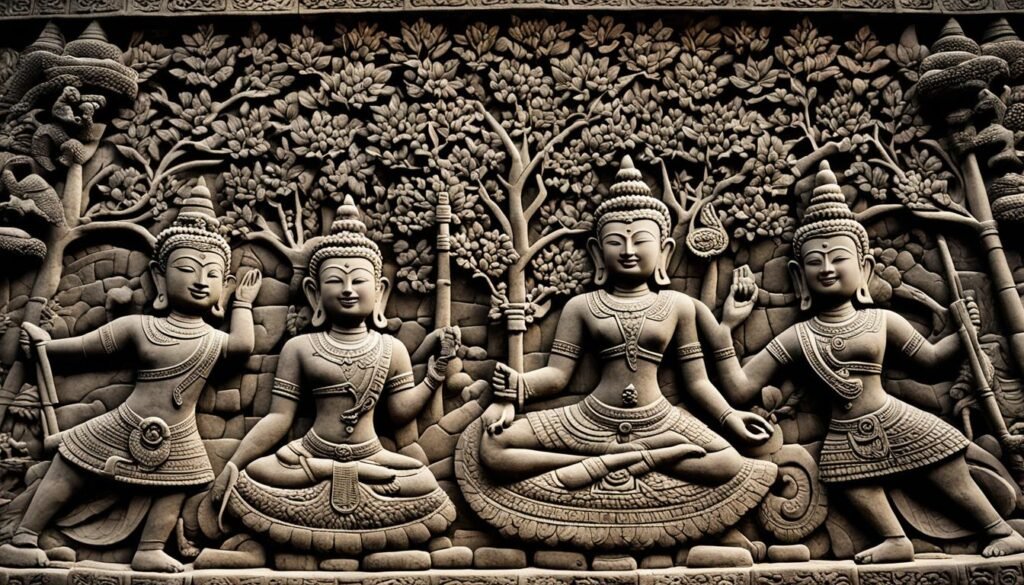Enveloped by the mist of time and Java’s lush landscape, the Borobudur Temple Yogyakarta beckons with its enduring magnetism. This 9th-century Mahayana Buddhist sanctum is more than just stone and sculpture; it is a vessel of Indonesian cultural heritage, rich with enigmas from a bygone era. Uncovered in 1814 by the notable Sir Thomas Stamford Raffles, Borobudur had slumbered beneath volcanic ash and jungle canopies, hidden from the world’s eyes. Today, as a UNESCO World Heritage Site, the temple continues to engross scholars and mystify visitors with its spiritual architecture, voluminous relief panels, and serene Buddha statues—a reflection of a civilization that intricately wove ancestor worship into its Buddhist practices. Not merely an entry in a list of Yogyakarta attractions, this historical marvel stands as a proud testament to the intricate tapestry of Borobudur Indonesia, immortalizing the zenith of the Sailendra Dynasty’s architectural prowess.
- Key Takeaways
- An Introduction to Borobudur Temple Yogyakarta
- The Architectural Grandeur of Borobudur Temple
- Mysteries Encased in Stone Reliefs and Statues
- Rediscovery and Restoration: Borobudur’s Renaissance
- Geographical Significance and Theories
- Borobudur Temple Yogyakarta: A Pilgrimage Site
- Understanding Borobudur: The Influence of Javanese and Indian Cultures
- The Iconography of Borobudur’s Buddha Statues
- Measuring Time Through Borobudur: From Eruption to Abandonment
- Conclusion
- Source Links
Key Takeaways
- Unearth the spiritual and architectural splendor of Borobudur Temple Yogyakarta.
- Discover the temple’s significance as a pivotal piece of Indonesian cultural heritage.
- Explore the historical importance of Borobudur since its rediscovery by Sir Thomas Stamford Raffles.
- Engage with the temple’s striking features, including over 500 Buddha statues and 2,672 relief panels.
- Recognize the temple’s prominence as a UNESCO World Heritage Site.
An Introduction to Borobudur Temple Yogyakarta
The Yogyakarta temple of Borobudur stands as a monumental beacon on Indonesia’s spiritual and cultural landscape. It invites devotees and travelers alike to embark on a Borobudur tour that offers insight into the world’s largest Buddhist temple complex and its rich historical tapestry. A pilgrimage to the Borobudur temple provides a unique intersection of devotion, history, and architectural grandeur.
Unveiling the Largest Buddhist Temple in the World
Nestled in the heart of Central Java, the Borobudur temple is not only a pivotal Buddhist pilgrimage site but also an archeological masterpiece, attributed to the Sailendra Dynasty’s vision in the 9th century. This colossal temple complex, infused with profound spiritual symbolism, occupies a staggering footprint, underscoring its status as the largest Buddhist temple in existence.
The Sailendra Dynasty’s Magnum Opus
Sculptured against a backdrop of rolling hills and verdant plains, Borobudur rises upward through nine voluminous platforms. It’s a symphony of Gupta and Javanese design philosophies, marrying India’s classical architecture with local artistry. Below the grand stupa, the temple walls are a visual anthology of Buddhist teachings, carved into stone with exceptional skill and fervor.
| Architectural Feature | Symbolic Representation | Cultural Influence |
|---|---|---|
| Central Dome | Path to enlightenment | Indigenous Javanese |
| Nine Platforms | Buddhist cosmology | Gupta Architecture |
| Relief Panels | Buddhist doctrines | Javanese storytelling |
| Stupas | Spiritual ascension | Blending of Javanese and Indian motifs |
The admiration for Borobudur’s craftsmanship deepens with the knowledge that this sanctuary was painstakingly restored in the 20th century, guided initially by Theodoor van Erp and later, emphatically by UNESCO. This restoration project not only salvaged the temple from the brink of permanent erosion but also reinstated its purpose as a center for Buddhist spiritual journey, cementing its reputation as a heritage site of global importance and ensuring that the Buddhist pilgrimage to Borobudur would continue for generations to come.
The Architectural Grandeur of Borobudur Temple
The majestic Borobudur Temple stands as a pinnacle of Buddhist architecture and a treasured Yogyakarta landmark. With a legacy that reverberates through time, it exemplifies the zenith of the Sailendra Dynasty’s architectural prowess. The temple’s structural integrity, achieved without the use of mortar, continues to inspire awe and command respect among architects and historians alike.
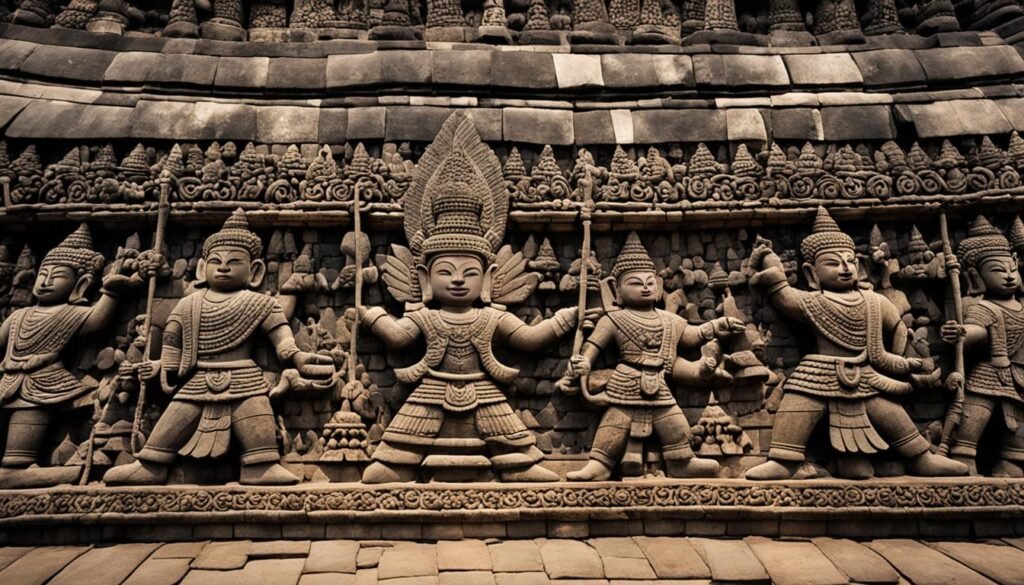
A Marvel of Interlocking Stone Blocks
The seamless cohesion of Borobudur’s stone blocks is a feat of engineering that has stood the test of time. The ingenuity of interlocking stone creates a stability that has endured both natural and human forces over centuries. This lattice of immense volcanic rock pieces acts as a silent narrator, telling the tale of a civilization that once thrived in the heart of Java.
Decoding the Symbolism of Borobudur’s Design
The temple’s edifice is not merely a structure but a profound representation of Buddhist cosmology. Every level of the Borobudur temple symbolizes a step in the journey towards enlightenment, guiding spiritual pilgrims towards ultimate liberation. The extensive stonework, from reliefs to statues, is a lexicon of symbolism waiting to be decoded by those who seek to understand the depths of Buddhist teachings.
Mysteries Encased in Stone Reliefs and Statues
The sheer scale and complexity of the Borobudur Indonesia is a wonder in itself, but the depth of narrative captured within its walls elevate this Buddhist temple to a keystone of cultural storytelling. The intricacies of the relief panels offer not just ornamentation but also a tangible record of ancient wisdom and transcendental beliefs. As one of the prime tourist attractions in Yogyakarta, Borobudur’s enigmatic nature continues to enthral and captivate scholars and visitors alike.
The Extensive Buddhist Lore on Borobudur Walls
Scattered across the compound, the lore of Buddhism finds remarkable representation on the walls of this iconic structure. Storytelling in these parts is done through stone and chisel, where every relief panel conveys a fragment of the larger spiritual dialogue. The tales depicted speak of ethics, enlightenment, and the universal truths of existence, all captured in detailed carvings that have survived the passage of time.
Delving Into the 2,672 Relief Panels
Borobudur’s vast array of relief panels is nothing short of an open book to the cosmos according to Buddhist thought. The vast tableau consists of elaborate scenes, recounting the Jataka tales and other significant episodes that chart the path from suffering to nirvana. These narratives carved in stone provide a visual guide to both the moral and the cosmic, weaving a complex philosophical tapestry that is uniquely preserved in its entirety only here at Borobudur.
Rediscovery and Restoration: Borobudur’s Renaissance
The resurgence of the majestic Borobudur Yogyakarta is a historic saga of rediscovery and restoration. Hidden for ages beneath layers of volcanic ash and thick jungle brush, it was Sir Thomas Stamford Raffles who, during his tenure as the Lieutenant-Governor of British Java, initiated the uncovering of this long-lost temple. Owing much to his colonial curiosity and subsequent actions, the Borobudur temple embarked on a journey towards its former glory.
The Role of Sir Thomas Stamford Raffles
Stumbling upon the Borobudur ruins in 1814, it was Raffles’s foresight and deep appreciation for local culture that spurred the initial efforts to restore the temple. His recognition of Borobudur’s significance incited a series of archaeological undertakings that ultimately paved the way for this sacred site to recapture its splendor and religious importance.
Borobudur Temple’s Massive UNESCO Restoration Project
The consolidation of Borobudur temple restoration took seismic strides in the 1970s when UNESCO orchestrated a comprehensive restoration project. This massive undertaking marshaled international expertise and vast resources, ultimately culminating in the temple’s listing as a UNESCO World Heritage Site. Not simply a refurbishment of stone, this meticulous rehabilitation restored the narrative of Borobudur as a testament to human devotion and creativity.

The following table highlights key aspects and figures from the UNESCO-led restoration project:
| Year | Activity | Funding | Global Impact |
|---|---|---|---|
| 1973-1983 | Comprehensive structural stabilization and conservation | US$6.9 million | Set a precedent for future heritage conservation projects |
| 1983-Present | Maintenance and ongoing site management | Funded by ticket sales and donations | Models sustainable practices for heritage site upkeep |
The effort demonstrated a remarkable synergy of ancient craftsmanship with modern conservation techniques, reaffirming the site’s cultural and spiritual importance. Indeed, the all-encompassing Borobudur temple restoration has not only preserved this ancient marvel but also offered a blueprint for the sustainable management of other heritage sites around the globe.
Geographical Significance and Theories
The majestic Borobudur Temple Compounds situated in Yogyakarta are not only significant for their historical and cultural value but also for their remarkable geographical context. The ancient builders chose an extraordinary site for this sacred structure, nestled in the central part of the Java island, adding depth to the already profound spirituality of the region’s historical landmark.
The Strategic Placement Between Volcanoes and Rivers
The Borobudur Temple is ingeniously situated between the Merapi and Merbabu volcanoes to the northeast and the Sundoro-Sumbing twin volcanoes to the northwest, with the Progo and Elo rivers flowing nearby. This proximity to natural features draws in numerous Yogyakarta attractions seekers who are eager to explore the “garden of Java.” Such a distinct and harmonious alignment with the natural world enhances the temple compound’s mysticism and has long been thought to be strategic in its role as a spiritual nexus.
The Enigmatic Ancient Lake Hypothesis
One of the most captivating theories about Borobudur is the Ancient Lake Hypothesis, which postulates that the site was once surrounded by a body of water, effectively creating an image of a lotus flower floating upon a lake. This conceptualization complements the representation of cosmic harmony and the ascent towards enlightenment central to Buddhist belief.
The table below offers insights into how the geographical placement of Borobudur Temple enhances its stature as a monumental Yogyakarta attraction and historical landmark:
| Geographical Feature | Relation to Borobudur | Theoretical Significance |
|---|---|---|
| Twin Volcanoes | Borobudur lies between two sets of twin volcanoes. | The positioning is thought to hold cosmological significance, echoing the Buddhist concept of balance between the elements. |
| Rivers – Progo and Elo | The temple is flanked by these ancient rivers. | In Asian traditions, waterways are often seen as spiritual paths, guiding the flow of cosmic energy around sacred sites. |
| The Ancient Lake Hypothesis | Theorists suggest that Borobudur was once surrounded by a lake. | If true, this would lend a serene and contemplative quality to the site, enhancing its reputation as a peaceful retreat for Buddhist practitioners. |
The exploration of these geographical marvels provides visitors and scholars alike with a deeper understanding of the Borobudur Temple Compounds not merely as a physical locale but as a platform where nature and spirituality converge magnificently.
Borobudur Temple Yogyakarta: A Pilgrimage Site
The Yogyakarta temple of Borobudur is more than a magnificent relic; it serves as a beacon of spiritual architecture that continues to draw individuals on a meaningful Buddhist pilgrimage. This monumental structure weaves together a physical and metaphysical journey, guiding pilgrims step by step towards a higher consciousness. Its corridors and stairways are not mere passageways but represent the passage from the mundane towards spiritual awakening.
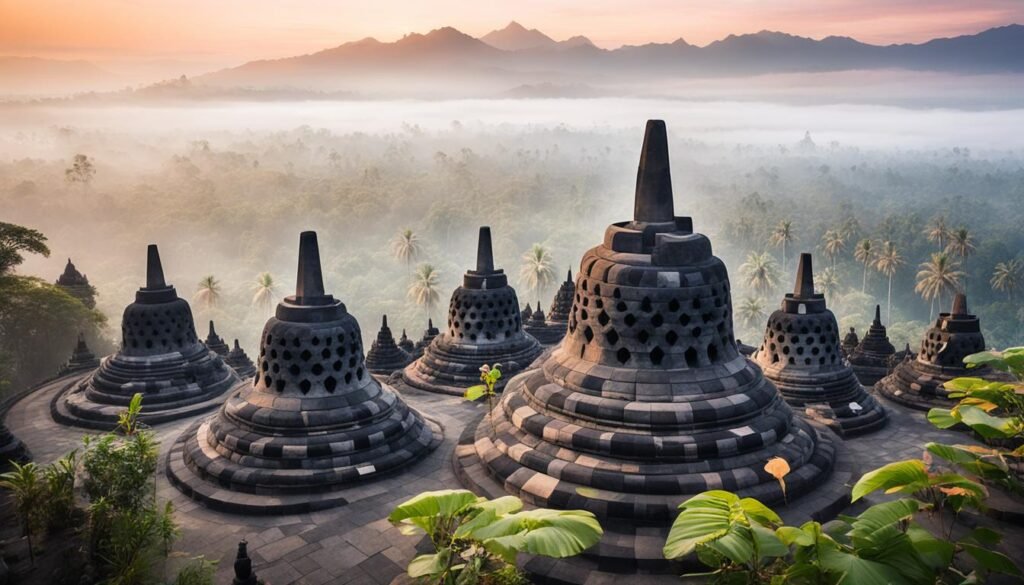
Each year, Borobudur’s role as a pilgrimage site culminates in the Vesak Day celebrations, enhancing its reputation as a focal point for reflection and religious ceremonies. On this auspicious day, the temple resonates with shared devotion, drawing believers from all corners of Indonesia and the globe. It’s a day when Borobudur transcends its physical form to become a vessel for universal Buddhist values.
- Symbolic Ascension – The layout of Borobudur is a physical representation of the spiritual journey towards enlightenment.
- Vesak Day Celebrations – An annual event that transforms Borobudur into a hub of Buddhist worship and contemplation.
- Global Pilgrimage Destination – Recognized internationally, it unites people from diverse backgrounds in a common spiritual pursuit.
“Each step taken within the hallowed corridors of Borobudur is a stride closer to the divine, enveloped by the scent of incense and the murmurs of mantras.”
Indeed, Borobudur Temple is not merely an architectural accomplishment; it serves as a living testament to the journey of faith, a sacred space that has withstood the test of time, continuing to elucidate the ever-relevant path of Dharma.
Understanding Borobudur: The Influence of Javanese and Indian Cultures
The Borobudur Temple Compounds, a pinnacle of Indonesian cultural heritage, present a compelling narrative of cultural confluence and religious harmony. This monument, nestled amidst the lush landscapes of Yogyakarta, is a prominent expression of Javanese Buddhist architecture. It stands as a profound connection between the local Indonesian traditions and the pervasive Indian influences that shaped Southeast Asia.
Blending Gupta Architecture with Indigenous Craftsmanship
At the heart of Borobudur’s construction lies the harmonious balance of Gupta architectural techniques and the indigenous craftsmanship of ancient Java. The temple’s design boasts the geometrically precise and sculptural forms characteristic of Gupta style merged seamlessly with the local stone-carving artistry. This melding of styles crafted not just a structure but a spiritual edifice that resonates with the echo of ancestral skills passed through generations.
The Spiritual Synthesis of Ancestors and Nirvana
Encompassing more than mere architectural innovation, Borobudur illustrates the spiritual synthesis of Indonesian ancestor worship with the Buddhist pursuit of nirvana. Each element of its intricate design, from the majestic stupas to the ascending platforms, mirrors a journey of philosophical exploration—a tangible reflection of the ethereal path from the earthly realm to transcendental enlightenment.

Distinctive to Borobudur are the narrative reliefs that illuminate Javanese perceptions of life and the afterlife, accentuating the pursuit of a higher existential state. These artistic representations are not only unparalleled in their detail and depth but also in their ability to encapsulate a legacy that is emblematic of an era where two worlds met and molded a unique cultural identity.
Consider the following table that encapsulates the synthesis of architectural and spiritual influences found at Borobudur:
| Element | Gupta Influence | Javanese Influence | Spiritual Significance |
|---|---|---|---|
| Stone Carving | Highly detailed relief work | Local volcanic stone material | Illuminates the Buddhist path of Dharma |
| Stupa Shape | Round, bell-shaped structures | Specific to Borobudur’s landscape | Symbolizes the arhat’s journey towards nirvana |
| Reliefs | Narration of the Jataka tales | Depiction of daily Javanese life | Merging folklore with canonical texts |
| Temple Layout | Graduated, ascending platforms | Mandala-inspired ground plan | Represents cosmic order and spiritual ascent |
The artistry of Borobudur thus stands as a testament to the brilliance of cross-cultural interactions that forged it—a sanctuary that not only honors the Javanese and Indian cultures but also exalts the human spirit in its endless quest for understanding and serenity.
The Iconography of Borobudur’s Buddha Statues
Borobudur Indonesia stands as a unique repository of Buddhist art and iconography, with the temple’s many Buddha statues offering a visual sermon of the path to enlightenment. Each of the statues conveys profound religious significance, captured meticulously within the stone.
The Significance of the 504 Buddha Sculptures
Within the sacred grounds of Borobudur, the 504 Buddha statues serve as silent teachers of the Dharma. These sculptures are not randomly placed; they are a visual guidebook to the dharma for pilgrims who traverse the temple’s circuits.
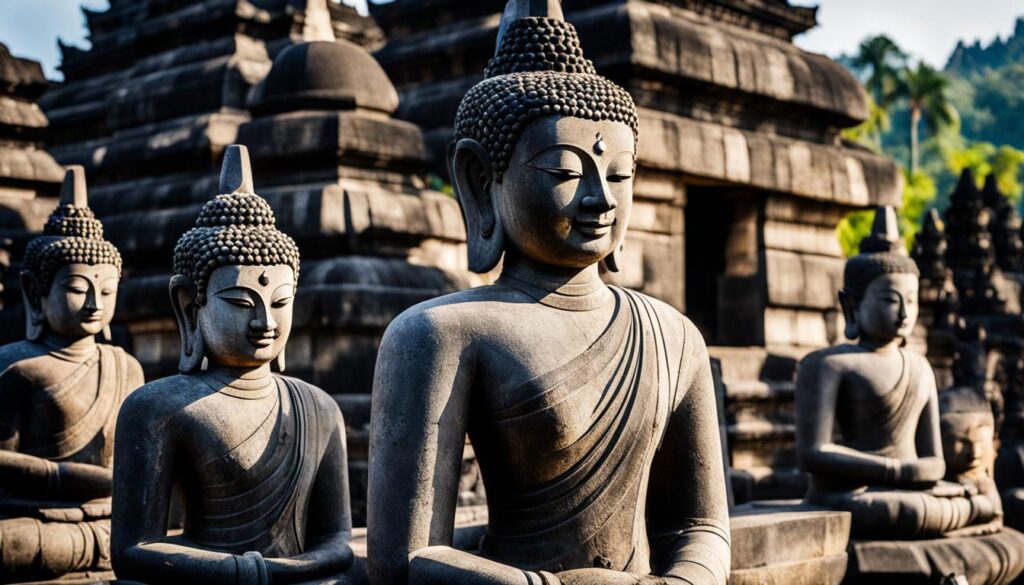
Reverence in the Details: Buddha’s Postures and Gestures
Borobudur’s Buddha statues are celebrated not just for their number but also for their diversity of postures and gestures, known as mudras. Each mudra signifies a different spiritual meaning, such as the Bhumisparsha Mudra (calling the Earth to witness), the Dharmachakra Mudra (setting the wheel of Dharma in motion), and the Dhyana Mudra (meditation).
| Mudra | Significance | Examples at Borobudur |
|---|---|---|
| Abhaya Mudra | Gesture of fearlessness and protection | Found on the upper terraces |
| Varada Mudra | Gesture of granting wishes or mercy | Common on lower platforms |
| Bhumisparsha Mudra | Calling the Earth to witness the Buddha’s enlightenment | Encased in the main stupa |
| Dharmachakra Mudra | Setting the teaching of Dharma in motion | Primarily in the east-facing statues |
| Dhyana Mudra | Gesture of meditation and concentration | Located on many of the temple’s platforms |
This interplay of iconography and architecture found at Borobudur translates to a profound spiritual and educational experience, as each detail contributes to the temple’s overarching narrative of the Buddha’s journey towards enlightenment.
Measuring Time Through Borobudur: From Eruption to Abandonment
Tracing the saga of the Borobudur Temple Compounds is akin to navigating through a labyrinth of time. This majestic historical landmark witnessed the ebb and flow of empires, survived the ravages of nature, and adapted to profound cultural shifts. As a paramount Yogyakarta landmark, its chronicles offer a glimpse into an era that shaped Java’s cultural landscape.
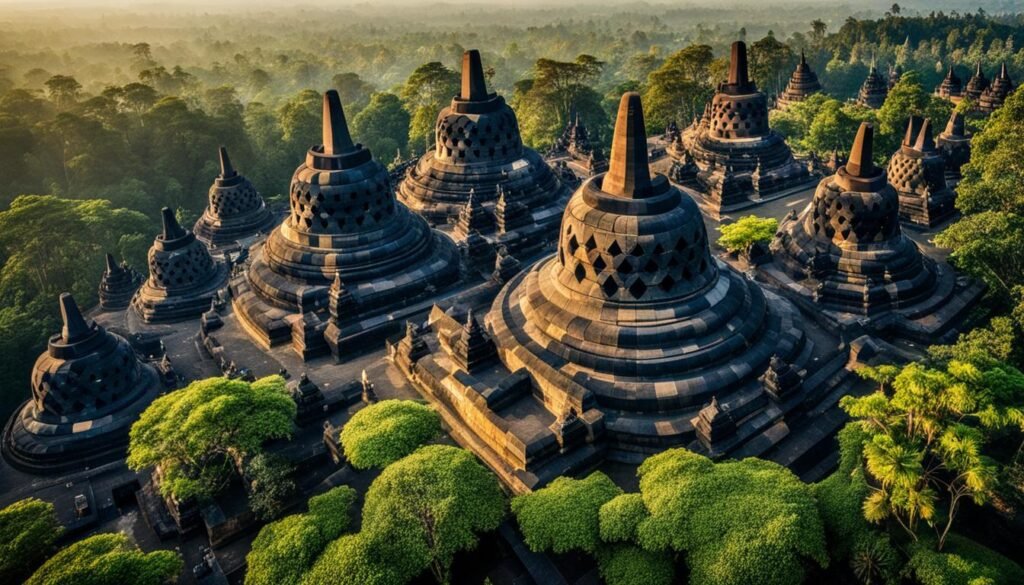
The Historical Timeline Surrounding Borobudur
Established in the 9th century, the Borobudur Temple has been a silent witness to the turning wheels of time. From the zenith of the Sailendra Dynasty’s architectural ingenuity to the subsequent abandonment that cloaked it in obscurity, each stone of Borobudur is a historical relic inscribed with tales of its prime and its plunge into oblivion.
The Consequences of Natural Disasters and Cultural Shifts
The landscape of Java bore the brunt of Mother Nature’s caprice, with volcanic eruptions casting a shadow over the temple’s grandeur. Furthermore, the tides of cultural transformations washed over the region, as dominance shifted from Buddhism to Islam. Yet, despite the shifts and the ensuing neglect, the integrity of Borobudur’s structure and spirit defied the centuries, a testimony to its resilience and enduring importance in Indonesia’s tapestry of heritage.
Conclusion
As we encapsulate the essence of Borobudur Temple’s illustrious past and present, it stands as a beacon of Indonesian cultural heritage—a monumental testament to spiritual and architectural ingenuity. The Borobudur tour experience offers more than a view into ancient craftsmanship; it offers insight into a tradition that shaped the essence of Yogyakarta and its surrounding regions. Each stone, sculpture, and relief at Borobudur Yogyakarta narrates part of a larger human story, one etched with perseverance and profound philosophical depth.
The Enduring Legacy of Borobudur Yogyakarta
Traversing the corridors of time, the legacy of Borobudur is as enduring as the stone it is carved from. Its presence on the world stage as a UNESCO World Heritage Site reinforces the import of its preservation. The essence of Borobudur transcends aesthetic admiration, inviting onlookers to reflect on the boundless potential of human dedication and spiritual pursuit. This iconic edifice is not merely a static relic of the past; rather, it continues to intrigue and inspire those who tread its noble paths.
Preserving a Masterpiece for Future Generations
Protecting this universal treasure demands a collective and ongoing commitment. Effort to sustain and celebrate Borobudur as an indelible piece of Indonesian cultural heritage remains a priority. The arduous task of conservation ensures that this marvel endures, allowing future generations to stand where ancient pilgrims once sought enlightenment. The global significance of Borobudur as a UNESCO World Heritage Site is a clarion call to uphold our shared history and its contributions to humanity’s cultural legacy.
FAQ
What is Borobudur Temple and why is it significant?
Borobudur Temple is a 9th-century Mahayana Buddhist temple in Yogyakarta, Indonesia. It is significant due to being the largest Buddhist temple in the world and a remarkable example of Indonesian cultural heritage. Borobudur is known for its massive size, intricate relief panels, and hundreds of Buddha statues. It is also a UNESCO World Heritage Site, highlighting its global cultural importance.
Who built the Borobudur Temple and when?
The Borobudur Temple was constructed in the 9th century during the reign of the Sailendra Dynasty.
What is the architectural style of the Borobudur Temple?
The architectural style of Borobudur Temple combines Indian Gupta architecture with indigenous Javanese elements. It features a unique design of interlocking stone blocks, nine platforms, and a central dome, making it a significant site for Buddhist architecture studies and a notable Yogyakarta landmark.
What are the relief panels on Borobudur’s walls about?
The relief panels on Borobudur’s walls depict various Buddhist teachings, including laws of karma, Jataka stories, and cosmic theories. In total, there are 2,672 relief panels that offer insight into Buddhist lore and philosophy.
How was the Borobudur Temple rediscovered and restored?
The Borobudur Temple was rediscovered in 1814 by Sir Thomas Stamford Raffles. It underwent a major restoration project in the 1970s, which was supported by UNESCO and involved international experts. This extensive effort helped to preserve the temple’s structure and intricate carvings.
What is the geographical significance of Borobudur Temple’s location?
The geographical significance of Borobudur Temple’s location lies in its placement between twin volcanoes and two rivers in Central Java. There are theories suggesting this strategic placement, along with the Ancient Lake Hypothesis, enhances the temple’s mystical and symbolic meanings.
Is Borobudur Temple still used for religious purposes today?
Yes, Borobudur Temple remains an active site for Buddhist pilgrimage and is especially central to the celebration of Vesak Day. Pilgrims journey up the temple’s stairways and platforms as part of their spiritual quest for enlightenment.
How do Javanese and Indian cultural elements merge in Borobudur’s design?
Javanese and Indian cultural elements merge in Borobudur’s design by integrating the geometrical and artistic styles of Indian Gupta architecture with Javanese craftsmanship and Buddhist symbolism. This blend reflects the rich cultural interaction and spiritual hybridization of its time.
What is the significance of the Buddha statues in Borobudur?
The 504 Buddha statues in Borobudur are significant for their iconography, with various postures and gestures known as mudras. They serve an instructive purpose, symbolizing the teachings and life stages of the Buddha.
How has Borobudur Temple endured through history?
Borobudur Temple has endured through a series of natural calamities, such as volcanic eruptions, and cultural shifts, including Java’s conversion to Islam. Despite these challenges, the temple’s resilience and its importance as a historical landmark and Yogyakarta attraction have persisted through centuries.

